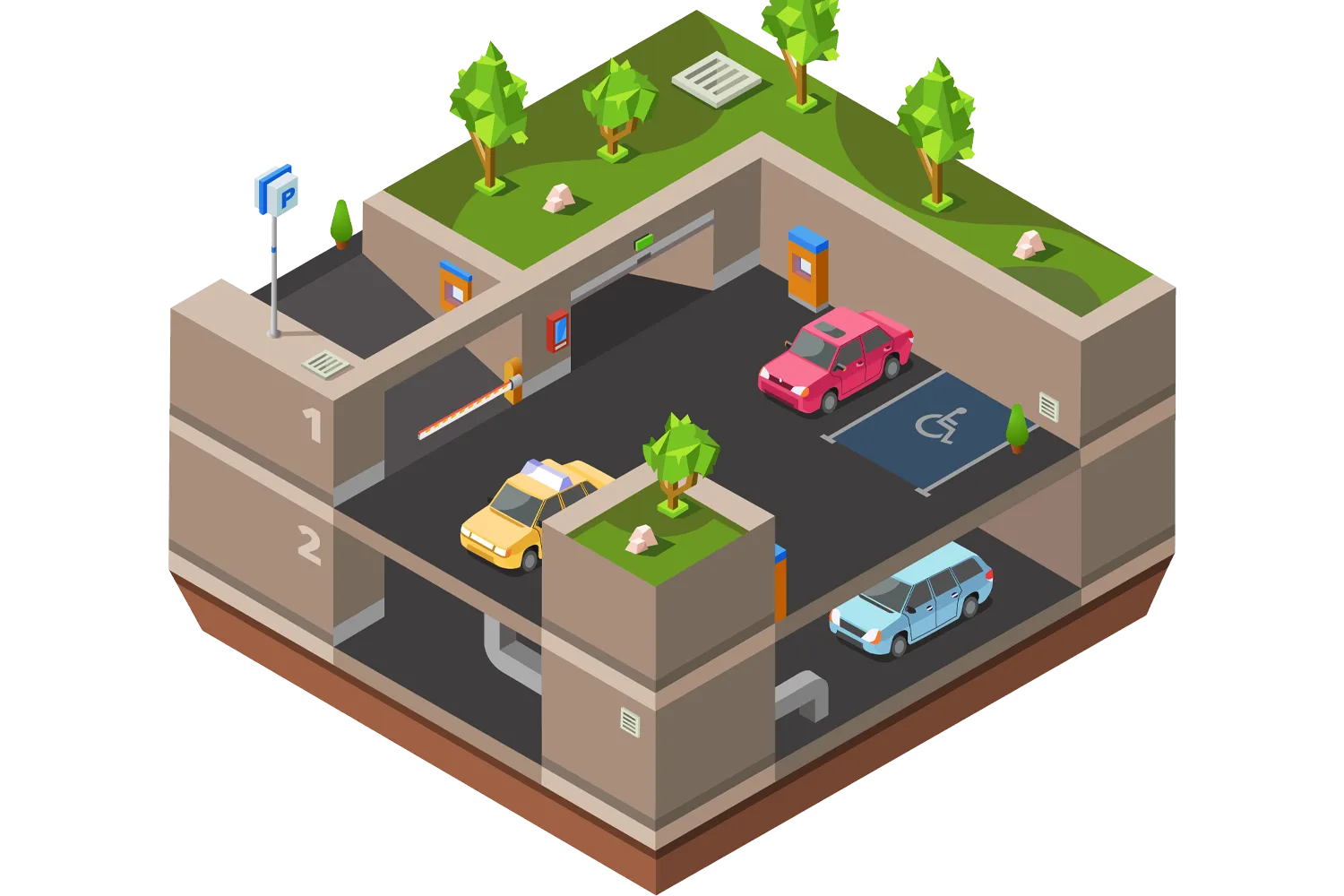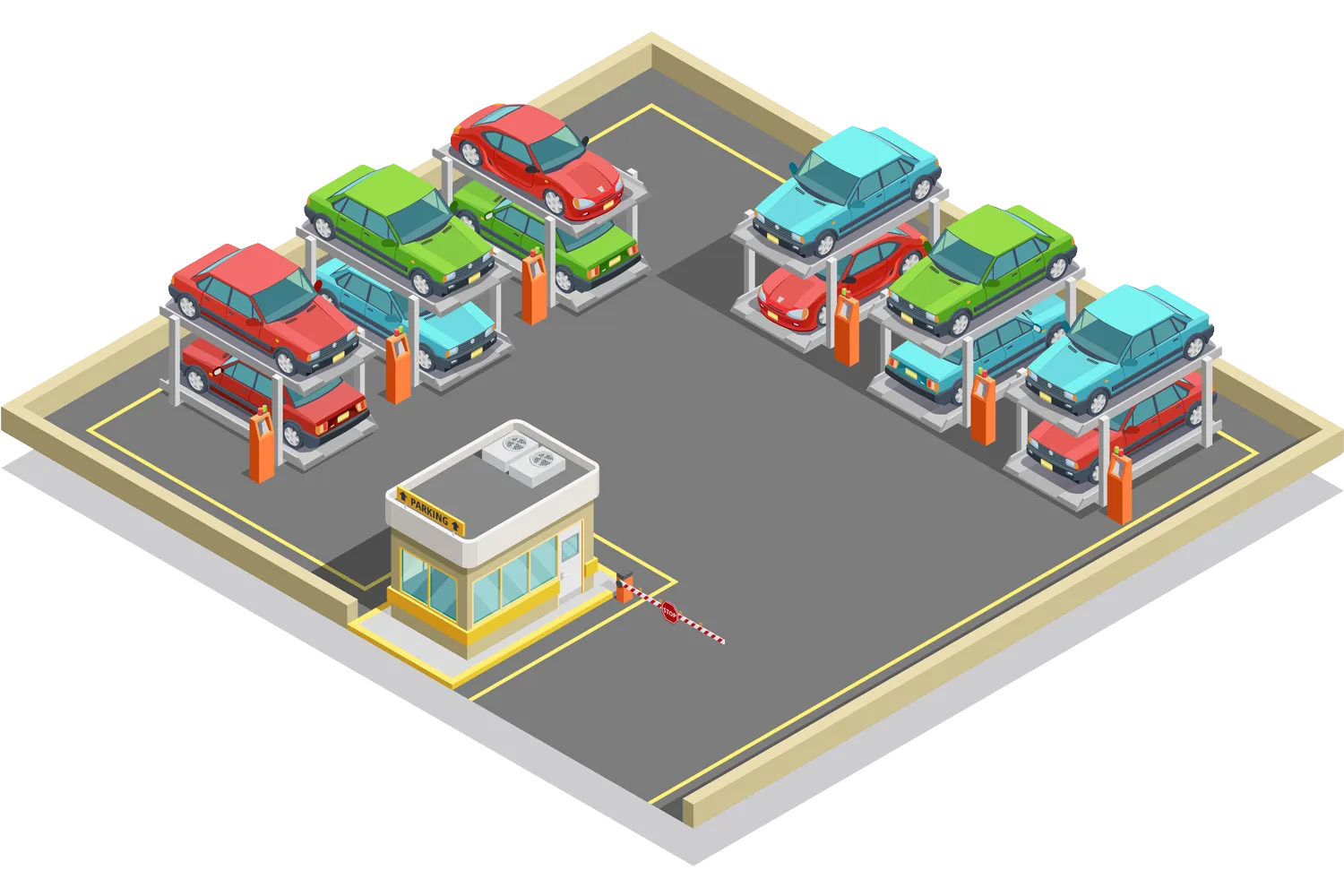Smart Parking Setup: Modern, No-Wait Experiences
With the increasing urban population and the growth of the number of cars, parking management has become one of the main challenges for cities. Setting up smart parking allows you to manage the entry, exit and payment of cars digitally, quickly and securely, creating a hassle-free experience for drivers.

Why is it important to set up smart parking?
Traditional parking lots often face problems such as long queues, time wasting, human errors, and poor security. Smart systems, using modern technologies, turn these problems into opportunities to improve user experience and management efficiency.
Step 1: Needs Analysis and Planning
The first and most important step in implementing a smart parking solution is to accurately understand the project’s needs. Without proper analysis, technology selection and infrastructure design may be inefficient or costly.
1. Parking capacity and number of cars per day:
To start, you need to know the capacity and throughput of your parking lot. Considering the number of cars using the parking lot daily, peak hours, and peak days will help you determine the correct number of kiosks, cameras, and sensors you need.
2. Peak hours and vehicle flow management:
Identifying busy times, such as morning or evening peaks, and planning to manage vehicle flow is key to reducing queues and traffic. This can include mechanisms such as fast-track entry, separate entry and exit lanes, and digital queuing.
3. Need for cash and electronic payment system:
Depending on the type of parking users, there may be a need for cash payments, bank card payments, or payments via mobile applications. A careful analysis of this need will help you select the right equipment and software and create a convenient and hassle-free experience for users.
4. Budget and available financial resources:
Once you have identified your needs and capabilities, you should consider your budget and financial resources. This step will help you select the right technologies without overspending and make better decisions about parking hardware and software.
With proper analysis and careful planning, you can select the best combination of technologies, equipment and processes for smart parking and get maximum efficiency from your investment. This step is the foundation for the success of the entire project and ensures that the smart parking setup is not only efficient, but also economical and reliable.

Step 2: Choosing the right technology and equipment
After analyzing the needs and planning, the next step in setting up a smart parking lot is selecting the right technologies and equipment. This step determines the quality of the user experience and the efficiency of parking management and includes hardware, software, and smart systems.
1. Entry and exit kiosks
Kiosks play a key role in registering vehicle entry and exit. These devices can include card readers, touch screens, and ticket printers. In smart parking lots, kiosks connect to a central system and license plate recognition cameras to automatically record entry and exit.
2. Automatic Number Plate Recognition (ANPR) System
ANPR cameras accurately record entry and exit information by recognizing license plates. This technology increases security, reduces human error, and speeds up the process of managing parking lot traffic.
3. Electronic and mobile payment system
One of the main features of smart parking is the ability to pay quickly and without waiting. Drivers can pay for parking via:
- Bank card and POS device
- Mobile app and digital wallet
- QR code or NFC system
Electronic payments reduce the need for human resources and increase customer satisfaction.
4. Central management software
The management software is the heart of the smart parking system. This software allows:
- Real-time monitoring of parking lots and vehicles
- Inbound and outbound traffic management
- Data analysis and production of management reports
With the management dashboard, parking managers can make decisions quickly and maximize parking efficiency.
5. Peripherals and sensors
To improve user experience and system accuracy, the use of peripherals is essential:
- Position sensors to detect full or empty
- Traffic lights and route guidance
- Digital queuing system to prevent congestion
- These devices make smart parking not only fast and safe, but also a comfortable and stress-free experience for drivers.
Step 3: Design and install infrastructure
After analyzing the needs and selecting the appropriate technologies, the next step in setting up a smart parking system is to design and install the hardware and software infrastructure. This step is considered the most fundamental part of the project’s success and ensures that the parking system operates quickly, safely, and error-free.
1. Installing kiosks at entry and exit points
Entry and exit kiosks are the main point of interaction between drivers and the system in a smart city. These kiosks are equipped with a touch screen, digital ticket printer and card reader. With proper installation in key locations, the process of entering and exiting vehicles is done automatically and without waiting. Also, these kiosks record the entry and exit information of vehicles by connecting to the central management software.
2. Installing license plate recognition cameras and smart sensors
ANPR (Auto Number Plate Recognition) cameras and smart parking sensors play a key role in increasing the accuracy and security of the system. The cameras identify and record license plates, and the parking sensors report the status of each parking space, whether it is empty or full. This data is transmitted in real time to the central software, allowing for traffic management, congestion reduction and security monitoring.
3. Creating a secure network and connecting to the central management system
Integrating all the equipment requires creating a secure and stable network. Data is transmitted from kiosks, cameras and sensors to central management software to:
- The entry and exit of vehicles should be recorded.
- Empty and full positions are displayed instantly.
- Payments and financial information should be managed carefully.
- Creating a secure network also prevents unauthorized access to information and potential misuse.
4. Ensuring information security and protecting user data
One of the most important points in setting up a smart parking system is maintaining data security. User information, vehicle details, and financial transactions must be encrypted and protected. In addition, the system must be able to cope with potential disruptions such as power outages, hardware failures, or cyber intrusions. Adherence to security standards and regular support ensures user trust and stable system performance.

Step 4: Initial testing and setup
Before the official opening of the parking lot, it is essential to check and test all system components to ensure proper and error-free operation. This key step in the launch of a smart parking lot includes the following:
Testing vehicle entry and exit in real conditions:
Ensuring the proper functioning of entry and exit kiosks and Automatic Number Plate Recognition (ANPR) cameras to accurately record vehicle entry and exit.
Review of the electronic payment system and the performance of POS devices:
Ensuring that cash, bank card, QR code, and mobile app payments are processed without errors and digital receipts are issued to users.
Simulating emergency situations:
Such as power outages, network disruptions, or hardware failures, to ensure that the system operates stably and without interruption and that data remains secure.
This step ensures that all problems are resolved before actual use and provides a safe, fast, and waiting-free experience for users. Following these tips is the foundation for success in launching smart parking and increasing customer satisfaction.
Step 5: Training users and staff
Although the smart parking system operates automatically, training users and personnel plays a key role in the success of the project and ensures that the user experience is smooth and trouble-free.
Driver training:
Drivers should be familiar with how to use smart kiosks, electronic payment systems, and mobile parking apps. This training includes the steps for entering and exiting a vehicle, paying online or with a QR code, and receiving a digital receipt.
Management personnel training:
Management personnel should be familiar with the smart parking central dashboard, real-time reports, parking space monitoring, and traffic management system. Proper personnel training will ensure optimal, fast, and error-free parking management.
With proper training of users and personnel, the smart parking system will perform optimally, customer satisfaction will increase, and parking manager productivity will be maximized.
Step 6: Exploitation and Optimization
After the official launch of the smart parking system, the operation and optimization phase is of great importance. The goal of this phase is to maintain optimal system performance, increase user satisfaction, and maximize the use of smart parking facilities.
Traffic and parking data analysis:
Using parking management software, managers can monitor the number of vehicles entering, stopping times, and empty spaces in real time and analyze the data. This analysis helps improve traffic flow and optimize space management.
Identifying weaknesses and opportunities to improve user experience:
By reviewing system performance reports and user feedback, process weaknesses are identified and solutions are provided to improve the driver experience and reduce queues.
Software and hardware updates:
Software and hardware systems must be updated regularly to maintain system performance and security. This ensures that smart parking always operates quickly, safely, and reliably.
Benefits of setting up smart parking
- Save time: Drivers enter or exit without waiting.
- Traffic reduction: Faster movement of vehicles makes traffic flow smoother.
- High security: License plate recognition and digital data recording increase vehicle security.
- Easy and fast payment: Online, mobile, and bank card payments are available.
- Smart and accurate management: Parking managers can check the status of spaces and revenue in real time.
Implementing smart parking not only makes the driving and parking experience simple and fast for users, but also allows parking managers to manage efficiently and increase productivity. By investing in this system, you can:
- Create a modern, wait-free experience for users
- Increase security and order in parking lots
- Optimize traffic and resource management
Smart parking is the future of urban management; an opportunity to reduce driver stress and increase parking efficiency.
